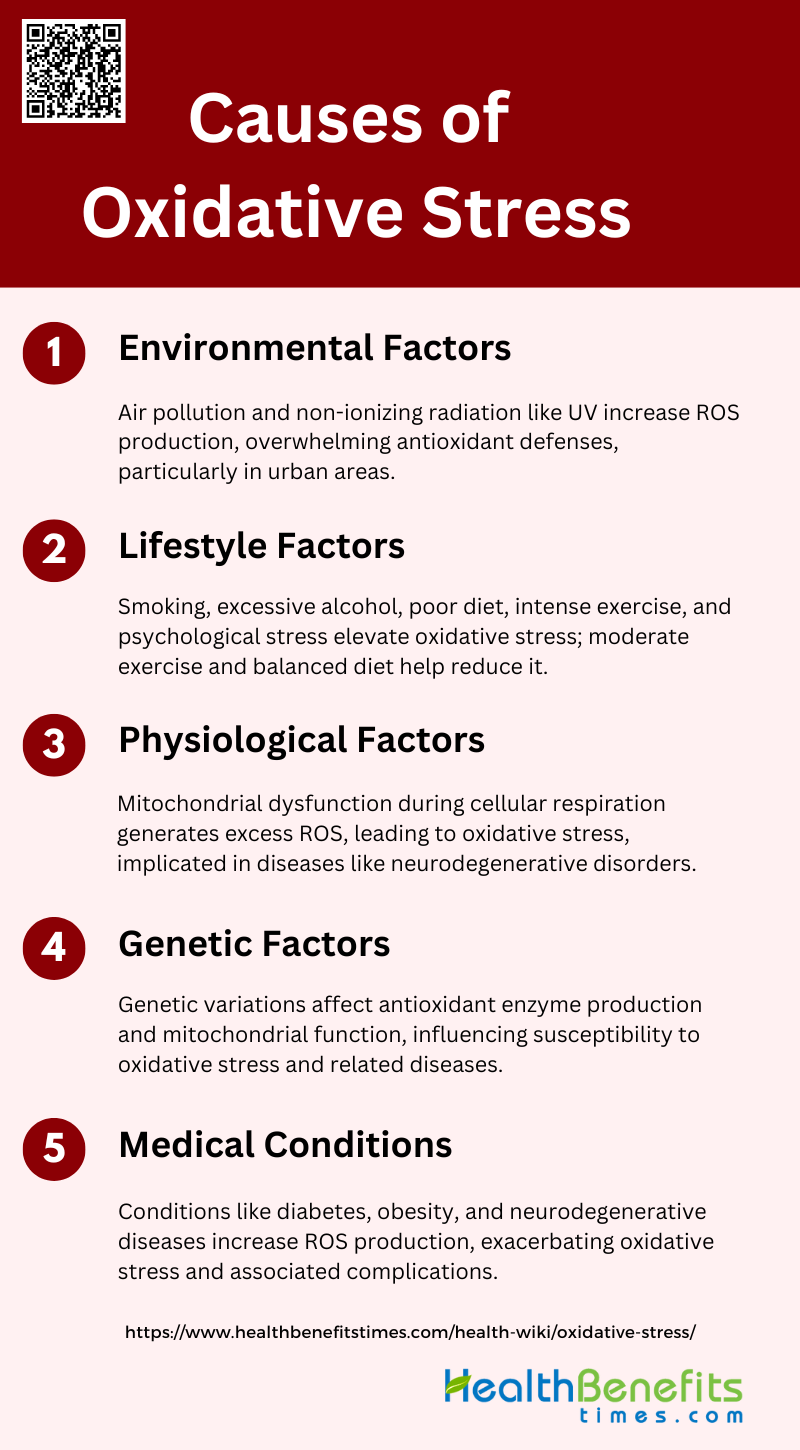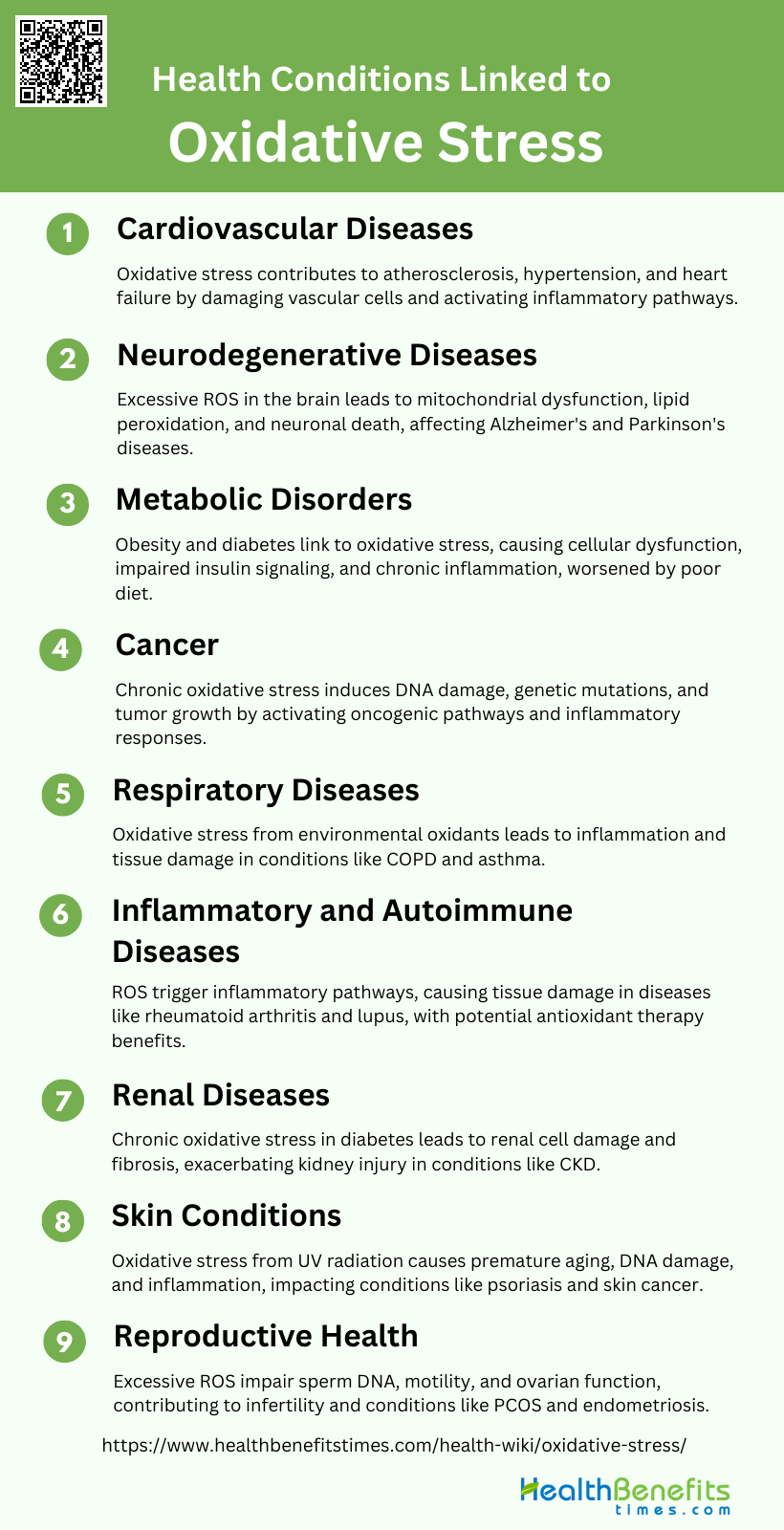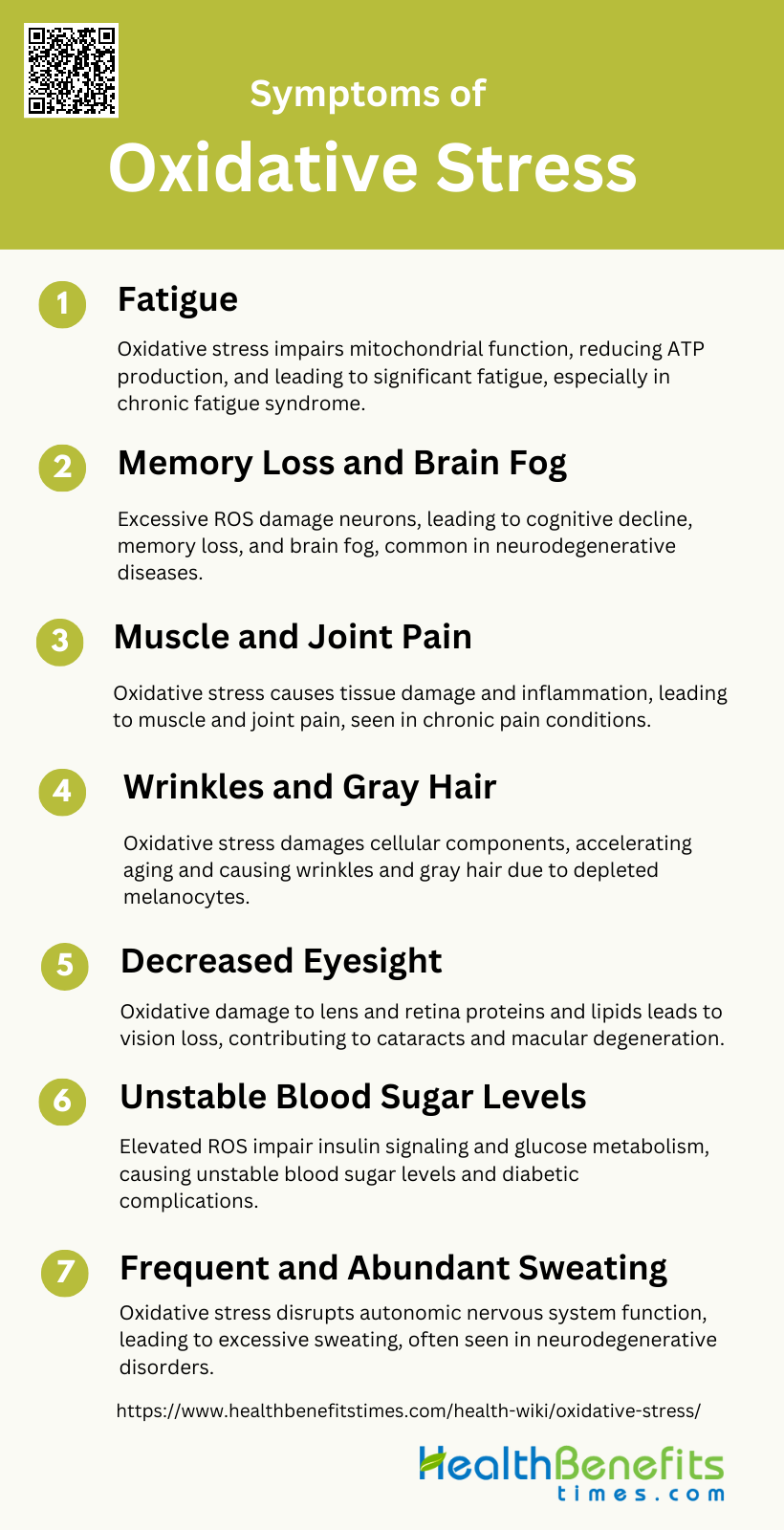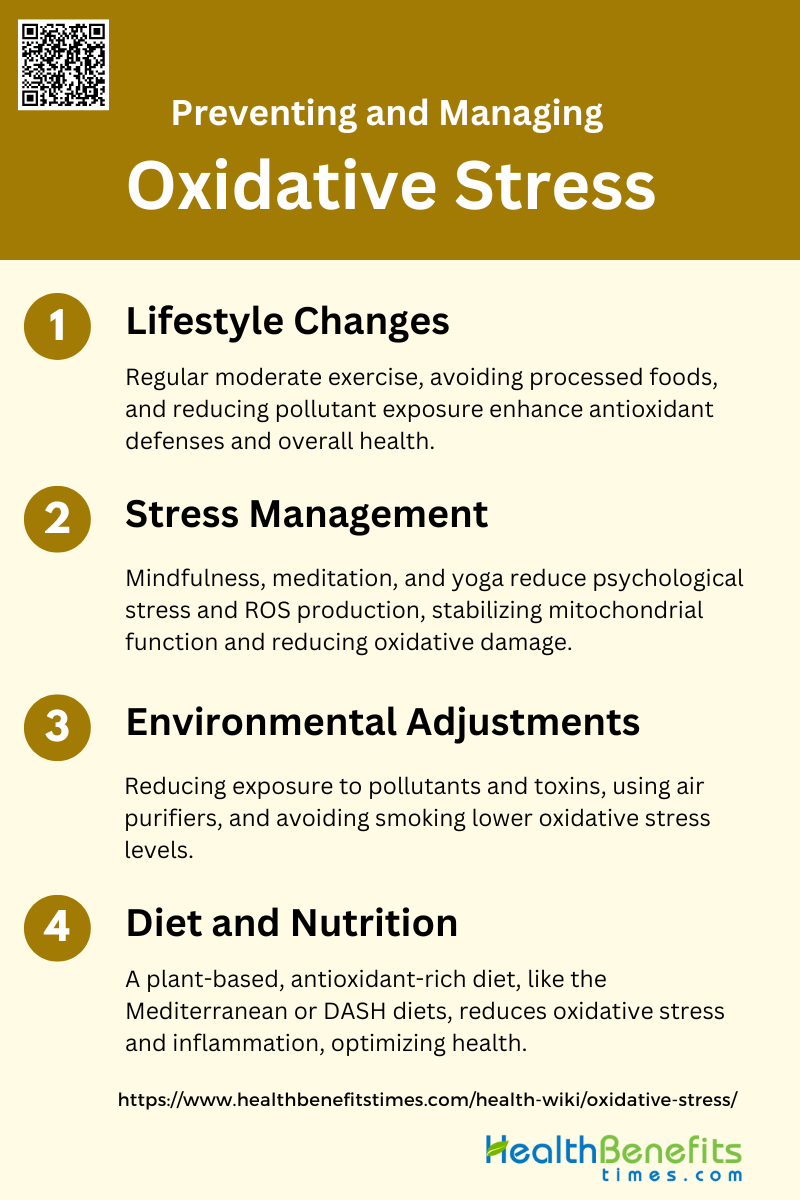Oxidative stress is a condition characterized by an imbalance between the production of reactive oxygen species (ROS) and the body’s ability to detoxify these harmful compounds or repair the resulting damage. This imbalance leads to the accumulation of oxidative damage to lipids, proteins, and DNA, which can contribute to the development of various diseases, including atherosclerosis, diabetes, cancer, and neurodegenerative disorders like Alzheimer’s disease. While oxidative stress is often harmful, it also plays a role in normal physiological processes such as cell signaling and immune response. The body employs antioxidant defenses, such as enzymes and dietary antioxidants, to mitigate oxidative stress, but when these defenses are overwhelmed, cellular damage and disease can ensue.
Causes of Oxidative Stress
Oxidative stress occurs when there is an imbalance between free radicals and antioxidants in the body. This imbalance can lead to cell and tissue damage, contributing to various health issues. Several factors can cause oxidative stress, including:
1. Environmental factors
Environmental factors play a significant role in the development of oxidative stress. Air pollution, including urban air contaminants, is a major contributor, as it introduces harmful particles and gases that increase the production of reactive oxygen species (ROS) in the body. Additionally, exposure to non-ionizing radiation, such as UV and microwaves, has been shown to elevate oxidative stress levels. These environmental stressors can overwhelm the body’s antioxidant defenses, leading to cellular damage and increased risk of chronic diseases. The impact of these factors is particularly pronounced in urban areas with high traffic pollution.
2. Lifestyle factors
Lifestyle choices significantly influence oxidative stress levels. Smoking and excessive alcohol consumption is well-documented sources of increased ROS production. Diet also plays a crucial role; while carbohydrate-rich diets may enhance resistance to oxidative stress, poor dietary habits can exacerbate it. Regular physical activity has a dual effect: while intense exercise can temporarily increase oxidative stress, moderate and consistent exercise improves the body’s antioxidant capacity, thereby reducing overall oxidative stress. Psychological stress is another lifestyle factor that can elevate oxidative stress, further highlighting the importance of a balanced lifestyle.
3. Physiological factors
Physiological processes, particularly those involving mitochondrial function, are central to the generation of oxidative stress. Mitochondria are the primary source of ROS during cellular respiration, and any impairment in mitochondrial function can lead to excessive ROS production. This mitochondrial oxidative stress is implicated in a variety of diseases, including neurodegenerative disorders and diabetes. Additionally, normal metabolic processes, such as energy production and immune responses, can generate ROS, which, if not adequately neutralized by antioxidants, contribute to oxidative stress.
4. Genetic Factors
Genetic predispositions can influence an individual’s susceptibility to oxidative stress. Variations in genes responsible for antioxidant enzyme production can affect the body’s ability to neutralize ROS. For instance, genetic mutations that impair mitochondrial function can lead to increased ROS production and oxidative stress. Furthermore, genetic factors may also determine the efficiency of repair mechanisms for oxidative damage, influencing the overall oxidative stress burden and the risk of developing related diseases.
5. Medical Conditions
Several medical conditions are closely associated with increased oxidative stress. Diabetes and obesity are prime examples, where elevated blood glucose levels and excess fat contribute to higher ROS production. These conditions can lead to complications such as insulin resistance and cardiovascular diseases, further exacerbating oxidative stress. Neurodegenerative diseases, such as Alzheimer’s, also involve significant oxidative stress due to the excessive production of ROS and impaired antioxidant defenses. Managing these medical conditions is crucial for reducing oxidative stress and its associated health risks.
Effects of Oxidative Stress on the Body
Oxidative stress can have a profound impact on various bodily functions and overall health. It occurs when there is an excess of free radicals that damage cells, proteins, and DNA. This can lead to numerous health issues, including:
1. Cellular and Molecular Damage
Oxidative stress results from an imbalance between reactive oxygen species (ROS) and antioxidants, leading to cellular and molecular damage. ROS can oxidize lipids, proteins, and DNA, causing structural and functional impairments. This damage disrupts cellular homeostasis, leading to cell death and contributing to various diseases. Mitochondrial dysfunction, impaired protein homeostasis, and altered cell signaling are common outcomes of oxidative stress, which can result in chronic inflammation and cytotoxicity.
2. Aging
Oxidative stress is a significant factor in the aging process. The accumulation of ROS over time leads to the damage of cellular macromolecules, including DNA, proteins, and lipids. This damage impairs cellular functions and promotes the aging process. Mitochondrial dysfunction and the accumulation of advanced glycation end products (AGEs) and advanced lipoxidation end products (ALEs) are associated with aging and age-related diseases such as neurodegenerative disorders and cardiovascular diseases.
3. Chronic Diseases
Oxidative stress is implicated in the pathogenesis of various chronic diseases, including diabetes, cardiovascular diseases, and neurodegenerative disorders. Excessive ROS production leads to cellular dysfunction, inflammation, and tissue damage. In diabetes, oxidative stress contributes to complications by promoting glycoxidation and lipoxidation of proteins and lipids. Similarly, in cardiovascular diseases, oxidative stress leads to endothelial dysfunction and atherosclerosis.
4. Inflammatory Conditions
Oxidative stress plays a crucial role in the development and progression of inflammatory conditions. ROS can activate inflammatory pathways, leading to the production of pro-inflammatory cytokines. This creates a vicious cycle where inflammation further increases ROS production, exacerbating tissue damage. Conditions such as rheumatoid arthritis and chronic prostatitis are associated with oxidative stress-induced inflammation.
5. Immune System Impact
Oxidative stress can impair the immune system by damaging immune cells and altering their functions. Excessive ROS can lead to the apoptosis of immune cells, reducing the body’s ability to fight infections. Additionally, oxidative stress can modulate immune responses, leading to chronic inflammation and autoimmune diseases. The balance between ROS and antioxidants is crucial for maintaining immune homeostasis.
6. Reproductive Health
Oxidative stress negatively impacts reproductive health, particularly in males. Excessive ROS can damage sperm DNA, lipids, and proteins, leading to decreased sperm motility and vitality. This is a significant factor in male infertility. Conditions such as chronic prostatitis are associated with increased oxidative stress, further compromising reproductive health. Antioxidants play a protective role in mitigating these effects.
7. DNA Damage
ROS can cause significant damage to DNA, leading to mutations and genomic instability. This damage includes base modifications, strand breaks, and cross-linking. DNA damage induced by oxidative stress is a critical factor in the development of cancer and other genetic disorders. The body’s ability to repair oxidative DNA damage is crucial for preventing these diseases.
8. Protein Damage
Oxidative stress leads to the oxidation of proteins, resulting in the formation of carbonyl groups and protein aggregates. This impairs protein function and can lead to the loss of enzyme activity, altered cell signaling, and protein degradation. Protein damage is associated with various diseases, including neurodegenerative disorders and metabolic diseases.
9. Lipid Peroxidation
Lipid peroxidation is a process where ROS oxidize lipids in cell membranes, leading to the formation of lipid peroxides. This damages cell membranes, disrupts cellular integrity, and generates toxic by-products such as malondialdehyde (MDA) and 4-hydroxy-2-nonenal (HNE). Lipid peroxidation is implicated in the pathogenesis of atherosclerosis, neurodegenerative diseases, and other chronic conditions.
Health Conditions Linked to Oxidative Stress
Oxidative stress is implicated in the development and progression of numerous health conditions. This occurs when there is an imbalance between free radicals and antioxidants, leading to cellular damage. Some of the health conditions linked to oxidative stress includes:
1. Cardiovascular Diseases
Oxidative stress plays a significant role in the pathogenesis of cardiovascular diseases (CVDs). The imbalance between reactive oxygen species (ROS) production and antioxidant defenses leads to oxidative damage in vascular cells, contributing to atherosclerosis, hypertension, and heart failure. Chronic oxidative stress activates inflammatory pathways, exacerbating vascular injury and promoting plaque formation in arteries. Persistent hyperglycemia in diabetes further increases ROS production, aggravating cardiovascular complications. Antioxidant therapies have shown potential in mitigating oxidative stress and improving cardiovascular health, although further research is needed to confirm their efficacy.
2. Neurodegenerative Diseases
Oxidative stress is a key modulator in the development and progression of neurodegenerative diseases such as Alzheimer’s, Parkinson’s, Huntington’s, and amyotrophic lateral sclerosis (ALS). The brain’s high oxygen consumption and lipid-rich environment make it particularly susceptible to oxidative damage. Excessive ROS production leads to mitochondrial dysfunction, lipid peroxidation, and protein oxidation, resulting in neuronal cell death. The interplay between oxidative stress and neuroinflammation further exacerbates neurodegeneration. Antioxidant therapies, including enzymatic and non-enzymatic antioxidants, are being explored to slow disease progression and alleviate symptoms.
3. Metabolic Disorders
Metabolic disorders, including obesity, type 2 diabetes, and metabolic syndrome, are closely linked to oxidative stress. The overproduction of ROS in these conditions leads to cellular dysfunction, impaired insulin signaling, and chronic inflammation. Hyperglycemia-induced oxidative stress damages pancreatic β-cells, reducing insulin production and contributing to insulin resistance. Nutritional stress from high-fat, high-carbohydrate diets further exacerbates oxidative damage. Antioxidant therapies and lifestyle modifications, such as diet and exercise, are potential strategies to mitigate oxidative stress and improve metabolic health.
4. Cancer
Oxidative stress is intricately linked to cancer development and progression. Chronic oxidative stress can induce DNA damage, genetic mutations, and activation of oncogenic pathways, leading to tumor initiation and growth. ROS-mediated activation of transcription factors such as NF-κB and p53 promotes cell survival, proliferation, and resistance to chemotherapy and radiotherapy. The inflammatory response triggered by oxidative stress further supports tumor progression and metastasis. Understanding the mechanisms of oxidative stress in cancer can aid in developing targeted therapies to inhibit tumor growth and enhance treatment efficacy.
5. Respiratory Diseases
Oxidative stress contributes to the pathogenesis of various respiratory diseases, including chronic obstructive pulmonary disease (COPD) and asthma. The lungs are constantly exposed to environmental oxidants, such as cigarette smoke and air pollutants, which increase ROS production. This oxidative burden leads to inflammation, tissue damage, and impaired lung function. Antioxidant defenses are often overwhelmed in these conditions, exacerbating disease severity. Therapeutic strategies aimed at enhancing antioxidant capacity and reducing oxidative stress hold promise for improving respiratory health.
6. Inflammatory and Autoimmune Diseases
Oxidative stress plays a crucial role in the development and progression of inflammatory and autoimmune diseases, such as rheumatoid arthritis and systemic lupus erythematosus. ROS production triggers inflammatory pathways, leading to tissue damage and chronic inflammation. Methotrexate, a common treatment for autoimmune diseases, has a dual role in modulating oxidative stress by both stimulating ROS production and reducing inflammation-induced oxidative damage. Antioxidant therapies may offer additional benefits in managing these conditions by reducing oxidative stress and inflammation.
7. Renal Diseases
Chronic oxidative stress is a key factor in the progression of renal diseases, including diabetic nephropathy and chronic kidney disease (CKD). Persistent hyperglycemia in diabetes increases ROS production, leading to renal cell damage and fibrosis. The interplay between oxidative stress, inflammation, and fibrosis creates a vicious cycle that exacerbates kidney injury. Antioxidant therapies and strategies to enhance endogenous antioxidant defenses are being explored to mitigate oxidative damage and slow the progression of renal diseases.
8. Skin Conditions
Oxidative stress is implicated in various skin conditions, including aging, psoriasis, and skin cancer. The skin is constantly exposed to environmental oxidants, such as UV radiation, which increase ROS production and cause oxidative damage to skin cells. This leads to premature aging, DNA damage, and inflammation. Antioxidant therapies, including topical and systemic antioxidants, are being investigated to protect the skin from oxidative damage and improve skin health.
9. Reproductive Health
Oxidative stress affects reproductive health by impairing gamete quality, fertilization, and embryo development. In males, excessive ROS production can lead to sperm DNA damage, reduced motility, and infertility. In females, oxidative stress can disrupt ovarian function, leading to conditions such as polycystic ovary syndrome (PCOS) and endometriosis. Antioxidant therapies and lifestyle modifications, such as diet and exercise, are potential strategies to improve reproductive health by reducing oxidative stress and enhancing antioxidant defenses.
Symptoms of Oxidative Stress
Oxidative stress occurs when there’s an imbalance between free radicals and antioxidants in your body, leading to cellular and tissue damage. This condition can manifest through various symptoms, which may affect different parts of the body. Here are some common symptoms of oxidative stress:
1. Fatigue
Fatigue is a common symptom associated with oxidative stress, particularly in conditions like chronic fatigue syndrome (CFS). Research indicates that patients with CFS exhibit significantly elevated levels of oxidative stress markers, such as isoprostanes and oxidized low-density lipoproteins, compared to healthy controls. These elevated markers correlate with the severity of fatigue and other symptoms in CFS patients, suggesting that oxidative stress plays a crucial role in the pathophysiology of this condition. Additionally, oxidative stress can impair mitochondrial function, leading to reduced ATP production and increased fatigue.
2. Memory Loss and Brain Fog
Oxidative stress is a significant factor in neurodegenerative diseases and cognitive decline. The brain’s high oxygen consumption and lipid-rich content make it particularly susceptible to oxidative damage. Excessive production of reactive oxygen species (ROS) can damage neuronal cells, leading to memory loss and brain fog. This is evident in conditions like Alzheimer’s disease and Parkinson’s disease, where oxidative stress contributes to the degeneration of neurons and cognitive impairment. The imbalance between ROS production and antioxidant defenses disrupts normal brain function, exacerbating symptoms of memory loss and brain fog.
3. Muscle and Joint Pain
Oxidative stress is implicated in the pathogenesis of various chronic pain conditions, including chronic prostatitis/chronic pelvic pain syndrome (CP/CPPS). Excessive ROS can damage tissues, leading to inflammation and pain in muscles and joints. In CP/CPPS, oxidative stress damages sperm DNA, lipids, and proteins, resulting in compromised vitality and decreased sperm motility, which can also manifest as muscle and joint pain. Additionally, oxidative stress is a common endpoint in chronic diseases like rheumatoid arthritis, where it contributes to tissue damage and pain.
4. Wrinkles and Gray Hair
Oxidative stress accelerates the aging process, leading to visible signs such as wrinkles and gray hair. The accumulation of reactive oxygen and nitrogen species (RONS) damages cellular components, including DNA, proteins, and lipids, which contributes to the aging of skin and hair follicles. This damage results in the loss of skin elasticity and the graying of hair due to the depletion of melanocytes. Environmental stressors like UV radiation further exacerbate oxidative stress, accelerating the appearance of wrinkles and gray hair.
5. Decreased Eyesight
Oxidative stress plays a critical role in the development of age-related eye diseases, such as cataracts and macular degeneration. The eyes are particularly vulnerable to oxidative damage due to their high exposure to light and oxygen. Excessive ROS can damage the proteins and lipids in the lens and retina, leading to decreased eyesight. Antioxidant defenses in the eye are often insufficient to counteract the high levels of oxidative stress, resulting in progressive vision loss. Therapeutic interventions targeting oxidative stress may help mitigate these effects and preserve eyesight.
6. Unstable Blood Sugar Levels
Oxidative stress is closely linked to the pathogenesis of diabetes and its complications. Elevated levels of ROS can impair insulin signaling and glucose metabolism, leading to unstable blood sugar levels. In diabetes, oxidative stress contributes to the formation of advanced glycation end products (AGEs) and lipid peroxidation products, which further exacerbate metabolic dysfunction. The imbalance between ROS production and antioxidant defenses disrupts normal cellular processes, resulting in fluctuating blood sugar levels and increased risk of diabetic complications.
7. Frequent and Abundant Sweating
Frequent and abundant sweating can be a symptom of oxidative stress, particularly in conditions that affect the autonomic nervous system. Oxidative stress can disrupt the normal functioning of the central nervous system (CNS), leading to dysregulation of autonomic processes, including sweating. Neurodegenerative diseases and neuropsychiatric disorders, which are associated with high levels of oxidative stress, often present with symptoms like excessive sweating due to impaired autonomic control. The imbalance between ROS production and antioxidant defenses can exacerbate these symptoms, highlighting the need for targeted therapeutic interventions.
How to Measure Oxidative Stress
Measuring oxidative stress involves assessing the balance between free radicals and antioxidants in the body. Various methods and biomarkers are used to evaluate this balance and determine the extent of oxidative damage. Here are some common techniques to measure oxidative stress:
1. Blood Tests
Blood tests are a common method for measuring oxidative stress, providing insights into the balance between reactive oxygen species (ROS) and antioxidants in the body. These tests often focus on biomarkers such as oxidized lipids, proteins, and DNA. For instance, the measurement of oxidized low-density lipoprotein (Ox-LDL) and F2-isoprostanes in plasma can indicate lipid peroxidation, a key marker of oxidative stress. Additionally, protein carbonyl groups, which form early and are relatively stable, can be detected in blood using assays like spectrophotometry and ELISA, providing a reliable measure of protein oxidation. The total antioxidant capacity of plasma is another parameter that can be assessed to gauge the body’s ability to counteract oxidative stress. These blood-based biomarkers are crucial for understanding the oxidative status in various diseases, including diabetes and cardiovascular conditions.
2. Urine Tests
Urine tests are another effective method for assessing oxidative stress, particularly through the measurement of specific biomarkers excreted in urine. One of the most widely used biomarkers is 8-hydroxy-2-deoxyguanosine (8-OHdG), which indicates oxidative damage to DNA. Studies have shown that urinary 8-OHdG levels can be stratified by factors such as body mass index, gender, and smoking status, making it a versatile marker for oxidative stress. Additionally, other oxidative stress biomarkers like malondialdehyde (MDA) and F2-isoprostanes, which indicate lipid peroxidation, and o,o’-dityrosine (diY), a marker of protein oxidation, can also be measured in urine. These biomarkers provide a non-invasive means to monitor oxidative stress and are particularly useful in longitudinal studies to track changes over time.
3. Other Diagnostic Tools
Beyond blood and urine tests, several other diagnostic tools are available to measure oxidative stress. Techniques such as flow cytometry can be used to assess ROS levels in leukocytes and platelets, providing a cellular perspective on oxidative stress. Spectrofluorimetry and ELISA are also employed to detect oxidative by-products in various biological samples, including breath and tissue biopsies. Additionally, the development of oxidative stress indexes, such as the Oxidative Stress Index (OSI) and the Oxidative Stress Score (OSS), offers a comprehensive approach by combining multiple biomarkers to provide an overall assessment of oxidative stress. These tools and techniques are essential for diagnosing and monitoring oxidative stress in clinical settings, aiding in the management of diseases like diabetes, cancer, and cardiovascular disorders.
Preventing and Managing Oxidative Stress
Oxidative stress can lead to various health issues, but there are effective strategies to prevent and manage it. By incorporating certain lifestyle changes and dietary adjustments, you can help maintain a healthy balance between free radicals and antioxidants. Here are some key methods to prevent and manage oxidative stress:
1. Lifestyle Changes
Adopting a healthier lifestyle can significantly reduce oxidative stress. Regular physical activity, particularly moderate exercise, has been shown to enhance endogenous antioxidant defenses and improve overall health. Additionally, avoiding processed foods and reducing exposure to environmental pollutants can help mitigate oxidative stress. Incorporating medicinal plants with antioxidant properties into daily routines may also offer protective benefits against chronic diseases
2. Stress management
Effective stress management techniques are crucial in preventing oxidative stress. Chronic psychological stress can lead to increased production of reactive oxygen species (ROS), contributing to oxidative damage. Practices such as mindfulness, meditation, and yoga can help reduce stress levels and, consequently, oxidative stress. These psychosocial interventions can stabilize mitochondrial structure and energy efficiency, further reducing oxidative damage.
3. Environmental adjustments
Minimizing exposure to environmental pollutants and toxins is essential in managing oxidative stress. Pollutants with oxidizing properties can significantly increase ROS production, leading to cellular damage. Implementing measures to reduce air pollution, using air purifiers, and avoiding smoking can help lower oxidative stress levels. Additionally, creating a cleaner and safer living environment can contribute to overall health and well-being.
4. Diet and Nutrition
A balanced diet rich in antioxidants is vital for combating oxidative stress. Plant-based diets, such as the Mediterranean and DASH diets, have been associated with lower levels of oxidative stress and inflammation. Consuming whole foods like strawberries and honey, which are rich in polyphenols, can also help reduce oxidative stress and inflammation. It is important to focus on natural food sources rather than relying solely on antioxidant supplements, as whole foods provide a synergistic effect that optimizes antioxidant benefits.







